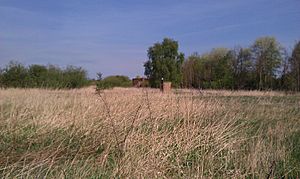Woolston Eyes facts for kids
Quick facts for kids Woolston Eyes |
|
|---|---|

Woolston Eyes, showing the main bird hide (erected c. 2010/11)
|
|
| Location | Warrington, England |
| Status | Site of Special Scientific Interest |
Woolston Eyes is a special nature area in Warrington, England. It's right next to the Manchester Ship Canal. This place is called a Site of Special Scientific Interest because it's super important for nature. It's also where mud and dirt, called 'dredgings,' from the Ship Canal are carefully placed. This is done with a special permission from the Environment Agency.
A group called the Woolston Eyes Conservation Group looks after this area. They manage it as a nature reserve. You need a special pass to visit. The name "Woolston Eyes" might sound a bit odd! It comes from an old language called Anglo-Saxon. In that language, ees meant land near a bend in a river.
Contents
Amazing Animals at Woolston Eyes
Woolston Eyes is a fantastic home for many different animals. It's especially famous for its birds.
Birds: A Feathered Paradise
This reserve is the best place in the UK to see black-necked grebes breeding. It's also a strong home for the willow tit. Many other birds also make their nests here. These include the tiny little grebe and the larger great crested grebe. You might also spot shelducks, Eurasian teals, and Northern shovelers.
Other interesting breeding birds are the water rail and the common cuckoo. Look out for the bright common kingfisher and the singing common grasshopper warbler. The Eurasian reed warbler also loves this place. In winter, many birds come to Woolston Eyes. Large numbers of Northern shoveler, Eurasian teal, gadwall, and common pochard spend their colder months here.
Reptiles and Amphibians: Scaly and Slimy Friends
Woolston Eyes is home to 12 different types of reptiles and amphibians. These are sometimes called herpetofauna. Some of these amazing creatures include the sand lizard and the smooth snake. You might also find the rare natterjack toad. All three types of newts that live in Britain can be found here too!
Insects: Dragonflies and Butterflies
This reserve is a buzzing place for insects. It has 21 different kinds of Odonata. These are dragonflies and damselflies. That's a lot, considering there are only 58 types found in all of Britain! You can also see 26 different kinds of butterflies fluttering around.
Caring for Woolston Eyes
The Woolston Eyes Conservation Group is a team of volunteers. They started in 1979. They work hard to protect the amazing wildlife here. They do this with permission from the Manchester Ship Canal Company.
What the Conservation Group Does
The main goal of the group is to study and protect the animals and plants. They are especially focused on the birds. The volunteers do hands-on work to keep the reserve a great place for birds. They also build and look after special hides. These hides are places where people can watch birds without disturbing them. The group also keeps the paths clear and makes sure animals are not bothered.
Supporting the Reserve
Every year, the group writes a report. This report shares what work they did and what they found. It includes scientific studies of the plants and animals. To do all this important work, the group needs money. They raise funds by selling special passes to the reserve. They also sell their Annual Reports. Sometimes, they apply for grants from other organizations.

